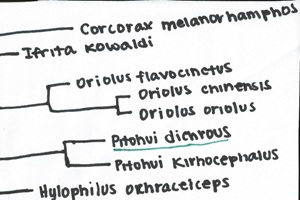Classification

Common Name: Hooded Pitohui
Scientific name: Pitohui dichrous
Domain Eukarya:
This domain encompasses a wide range of organisms including plants, animals, fungi and protists. These organisms are characterized by the presence of a true nucleus (eukaryotic cells). Organisms in this domain can be unicellular or multicellular. Also there is a presence of membrane bound organelles like the mitochondria and chloroplast. The mitochondria is responsible for cellular respiration and the production of ATP (adenosine triphosphate) for energy. Chloroplasts, however, are only present in plants and produce the foodstuffs for the organism (Domain Eukarya).
Kingdom Animalia:
This kingdom encompasses all of the animals, which are heterotrophic and multicellular. All animals lack cell walls, which allows for complex movement compared to the plants and fungi. Most animals reproduce sexually thorough the use of sperm and egg. The organisms in this kingdom are diploid and give rise to diploid offspring. Other organisms in this kingdom include fish, sponges, and even humans!
Phylum Chordata:
This phylum includes a unique set of characteristics that include a notochord, pharyngeal gill slits, an endostyle, post-anal tail and a tubular nerve chord. These characteristics must be present at some point in development in order to be classified as a chordate. The chordates exhibit bilateral symmetry that allows for greater cephalization. These organisms have a complete digestive tracts and a closed circulatory system. Additionally, these organisms have three germ layers and develop in the deuterostome fashion. This phylum is shared with organisms like the lancet, reptiles and amphibians (Animal Diversity Web).
Class Aves:
This class includes the birds of flight as well as some birds that have lost the ability to do so (ostriches and emus). Birds have evolved feathers that aid in flight. These birds have a hollow bone structure that provides strength but also allows for a light skeleton for flight. The eggs of these birds are some of the largest amniotic eggs and have allowed for a decreased dependence on an aquatic environment.
Order Passeriformes:
This order of birds encompasses the largest amount of bird species. All of the members are perching birds that possess special feet in which three toes point forward and one points backwards. This foot structure enhances the gripping capacity as the birds travel through the trees. Another defining characteristic is the syrinx that is located in the trachea of these birds that allows for unique songs. Other birds that belong to this family include warblers and thrushes. (Zip code Zoo)
Family Pachycephalidae:
This family is often referred to as the "whistler" family because of their unique song style. Another common name is the thickheaded birds due to the large cerebral structures. The plumage of these birds can be relatively subtle tones of brown and grey but also can be incredibly colorful. This family also covers the shrike-thrushes, shrike-tits and pitohuis.
Genus Pitohui:
This genus is specific to New Guinea and is known to contain the only known species of poisonous birds. The birds of this genus typically exhibit aposematic coloring to warn predators against the deadly toxins they possess.
This polyphyletic tree is based of of molecular genetics.
Photo drawn by author. Adapted from the hyperlinked image.
Check out this unique organisms' habitat
